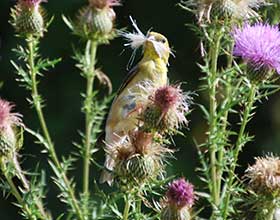 Complete the sentence, “Thistles are _______.” Weeds? Prickly? Bothersome? Invasive? A lot of the obvious choices to fill in that blank carry a negative connotation. And there are good reasons for all of those choices! Yet thistles also have substantial positive attributes, and they are valuable—even invaluable, in some ways–members of our local ecological communities.
Complete the sentence, “Thistles are _______.” Weeds? Prickly? Bothersome? Invasive? A lot of the obvious choices to fill in that blank carry a negative connotation. And there are good reasons for all of those choices! Yet thistles also have substantial positive attributes, and they are valuable—even invaluable, in some ways–members of our local ecological communities.
“Thistles” comprise a group of plants in the aster family (Asteraceae), especially those in the genera Carduus, Cirsium, and Onopordum, that are characterized by purplish fluffy flower heads and leaves with spiny margins. About a half-dozen species of thistles are found in Greene and Montgomery Counties. Of those, two (field thistle and swamp thistle) are native to this area. The others, including the rather common creeping, musk, and bull thistles, were introduced from Europe as long as several hundred years ago.
The most notable feature of thistles probably is their spines. A dense patch of thistles really does present an impenetrable barrier. No doubt, thistle spines evolved as a deterrent to herbivores, and deer certainly know to avoid munching on thistle leaves. Despite that, a number of beetles and other insects feed on thistle flowers, seeds, and even leaves, and painted lady butterflies even use thistles as a host plant for their caterpillars.
On the other hand, two features of thistles are highly attractive to wildlife. The first is their nectar. Many species of thistles, particularly those that are biennials like musk and swamp thistle, produce copious amounts of nectar. As a result, many butterflies, bees (including the distinctive thistle longhorn bee), flies, beetles, and other insects are attracted to thistle flowers. Even hummingbirds feed at thistles, especially the larger flowers like bull thistle. Locally, creeping thistle, Cirsium arvense, is one of the more abundant introduced thistle species, and it is considered invasive in Ohio. Creeping thistle is perennial, creating dense clonal colonies each year from its persistent roots. Even in its native Europe, creeping thistle is considered a weed—but it still is a strong nectar producer, and it attracts a lot of insects.
Thistles may be particularly important for monarch butterflies. Monarchs usually are associated with milkweeds, which serve as host plants for the species’ caterpillars. However, thistles may be nearly as critical, as they provide late summer nectar to fuel the butterflies’ southward migration after most other flowers have faded from the landscape.
The second feature of thistles that is valued by wildlife is the fluffy mass of seeds. As members of the Asteraceae family, each thistle flower head actually consists of hundreds of individual small flowers. And each of those flowers produces a seed that is attached to a feathery tuft of fluff that facilitates dispersion by the wind. The result is the characteristic white fluffy mass that develops as the flowers age. Both the seeds, which are used as food by various birds (sparrows, buntings, finches, and others) and rodents, and the fluff itself, which makes great nesting material for birds and mice, are valuable resources.
The only problem with thistle fluff as nesting material for birds is that thistles tend to flower relatively late in the season, after the nesting season of most birds. But one bird in particular has overcome that obstacle. Goldfinches don’t nest until late July or early August, the latest of our songbirds, and they time their nesting precisely to coincide with when thistles go to seed. What that means is that goldfinches are stimulated to nest at a time when day length is declining, well after the summer equinox. That’s the opposite of most temperate zone birds, whose reproductive hormones are triggered by increasing day length. Reproductive condition in goldfinches may be tied to environmental cues like light and temperature, but it also seems to be reinforced by the sight of thistle flowers and by consumption of thistle seeds.
Goldfinches take advantage of both elements of the late-stage thistle flower. First, goldfinches harvest thistle fluff to line their nest. It’s not hard to imagine that this creates a nice soft base on which to lay eggs. The packed fluff creates a strong, insulating cup, dense enough that it actually risks accumulating rainwater and flooding the chicks. Second, goldfinches harvest the seeds for food. These are eaten by the adults, similar to the niger (not thistle) seed sold commercially for winter goldfinch feeders. But goldfinches are unusual as one of the only birds that also feeds seeds to the nestlings. Even most finches that eat seeds as adults feed insects to the growing young. One side benefit of this habit is that it provides protection against parasitism by cowbirds, which lay their eggs in the nests of many species; cowbird chicks cannot survive on the goldfinch diet of seeds.
Thistles really do embody a combination of opposites. They are spiny but fluffy, weedy but beautiful, forbidding to some animals but critical to others. Not too many gardeners are likely to begin adding thistles to their flower beds. But out in our meadows and prairies, a patch of thistles can provide rich wildlife habitat. The thistle has been the national flower of Scotland for something like 750 years. Supposedly that’s because an invading soldier stepped on a thistle and cried out, alerting the Scots to his presence. But no doubt they also valued the flowers as elements of the landscape and boons to wildlife. As should we!
Article and photo contributed by Dr. David L. Goldstein, Emeritus Professor, Department of Biological Sciences, Wright State University.
